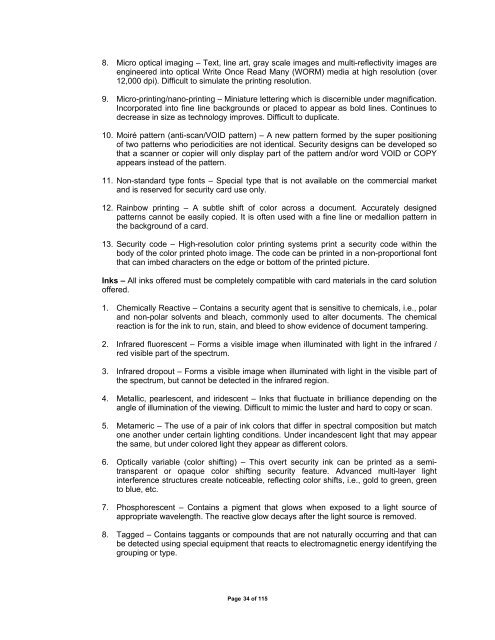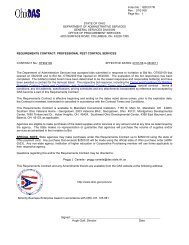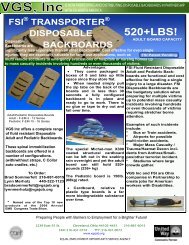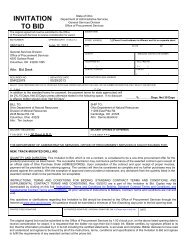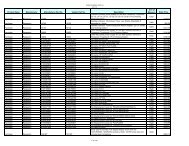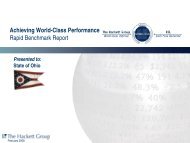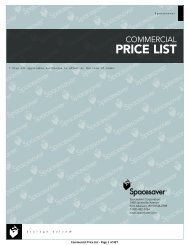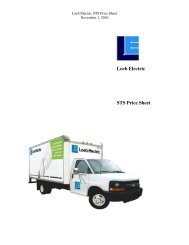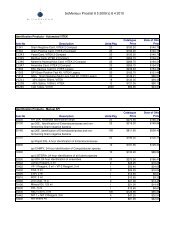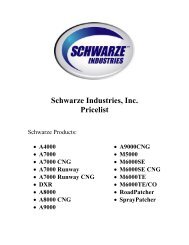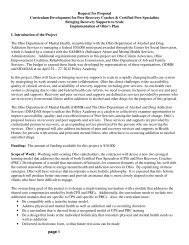REQUEST FOR PROPOSALS RFP NUMBER: 0A1031 DATE ISSUED
REQUEST FOR PROPOSALS RFP NUMBER: 0A1031 DATE ISSUED
REQUEST FOR PROPOSALS RFP NUMBER: 0A1031 DATE ISSUED
You also want an ePaper? Increase the reach of your titles
YUMPU automatically turns print PDFs into web optimized ePapers that Google loves.
8. Micro optical imaging – Text, line art, gray scale images and multi-reflectivity images are<br />
engineered into optical Write Once Read Many (WORM) media at high resolution (over<br />
12,000 dpi). Difficult to simulate the printing resolution.<br />
9. Micro-printing/nano-printing – Miniature lettering which is discernible under magnification.<br />
Incorporated into fine line backgrounds or placed to appear as bold lines. Continues to<br />
decrease in size as technology improves. Difficult to duplicate.<br />
10. Moiré pattern (anti-scan/VOID pattern) – A new pattern formed by the super positioning<br />
of two patterns who periodicities are not identical. Security designs can be developed so<br />
that a scanner or copier will only display part of the pattern and/or word VOID or COPY<br />
appears instead of the pattern.<br />
11. Non-standard type fonts – Special type that is not available on the commercial market<br />
and is reserved for security card use only.<br />
12. Rainbow printing – A subtle shift of color across a document. Accurately designed<br />
patterns cannot be easily copied. It is often used with a fine line or medallion pattern in<br />
the background of a card.<br />
13. Security code – High-resolution color printing systems print a security code within the<br />
body of the color printed photo image. The code can be printed in a non-proportional font<br />
that can imbed characters on the edge or bottom of the printed picture.<br />
Inks – All inks offered must be completely compatible with card materials in the card solution<br />
offered.<br />
1. Chemically Reactive – Contains a security agent that is sensitive to chemicals, i.e., polar<br />
and non-polar solvents and bleach, commonly used to alter documents. The chemical<br />
reaction is for the ink to run, stain, and bleed to show evidence of document tampering.<br />
2. Infrared fluorescent – Forms a visible image when illuminated with light in the infrared /<br />
red visible part of the spectrum.<br />
3. Infrared dropout – Forms a visible image when illuminated with light in the visible part of<br />
the spectrum, but cannot be detected in the infrared region.<br />
4. Metallic, pearlescent, and iridescent – Inks that fluctuate in brilliance depending on the<br />
angle of illumination of the viewing. Difficult to mimic the luster and hard to copy or scan.<br />
5. Metameric – The use of a pair of ink colors that differ in spectral composition but match<br />
one another under certain lighting conditions. Under incandescent light that may appear<br />
the same, but under colored light they appear as different colors.<br />
6. Optically variable (color shifting) – This overt security ink can be printed as a semitransparent<br />
or opaque color shifting security feature. Advanced multi-layer light<br />
interference structures create noticeable, reflecting color shifts, i.e., gold to green, green<br />
to blue, etc.<br />
7. Phosphorescent – Contains a pigment that glows when exposed to a light source of<br />
appropriate wavelength. The reactive glow decays after the light source is removed.<br />
8. Tagged – Contains taggants or compounds that are not naturally occurring and that can<br />
be detected using special equipment that reacts to electromagnetic energy identifying the<br />
grouping or type.<br />
Page 34 of 115


